Abstract
The possible existence of kinetic interactions between rifampicin and isoniazid and the effect of the concomitant presence of an impaired liver function were investigated in man.
In a first study normal healthy subjects and patients with chronic liver disease received, on three different occasions, a single dose of 600 mg rifampicin or isoniazid and of rifampicin and isoniazid associated in randomized sequences. The results have shown that in both groups the serum levels, half-life values, and urinary excretion of each drug given alone are not significantly different from those observed when the other drug is associated. Serum levels and half-life of rifampicin and isoniazid were significantly higher in patients with chronically impaired liver.
In a second study, rifampicin and isoniazid were given in combination at the same doses as in the first study over a period of one week. The results have shown a trend to decrease in the serum levels of rifampicin of the healthy subjects and a trend to increase in the patients with chronic liver disease on day 7 of treatment. In both groups a reduction in the half-life of rifampicin was also observed. No changes in serum isoniazid concentrations were observed between day 1 and day 7 in the healthy subjects, whereas a significant increase was observed in the patients. No significant changes in the half-life of isoniazid were observed.
Full text
PDF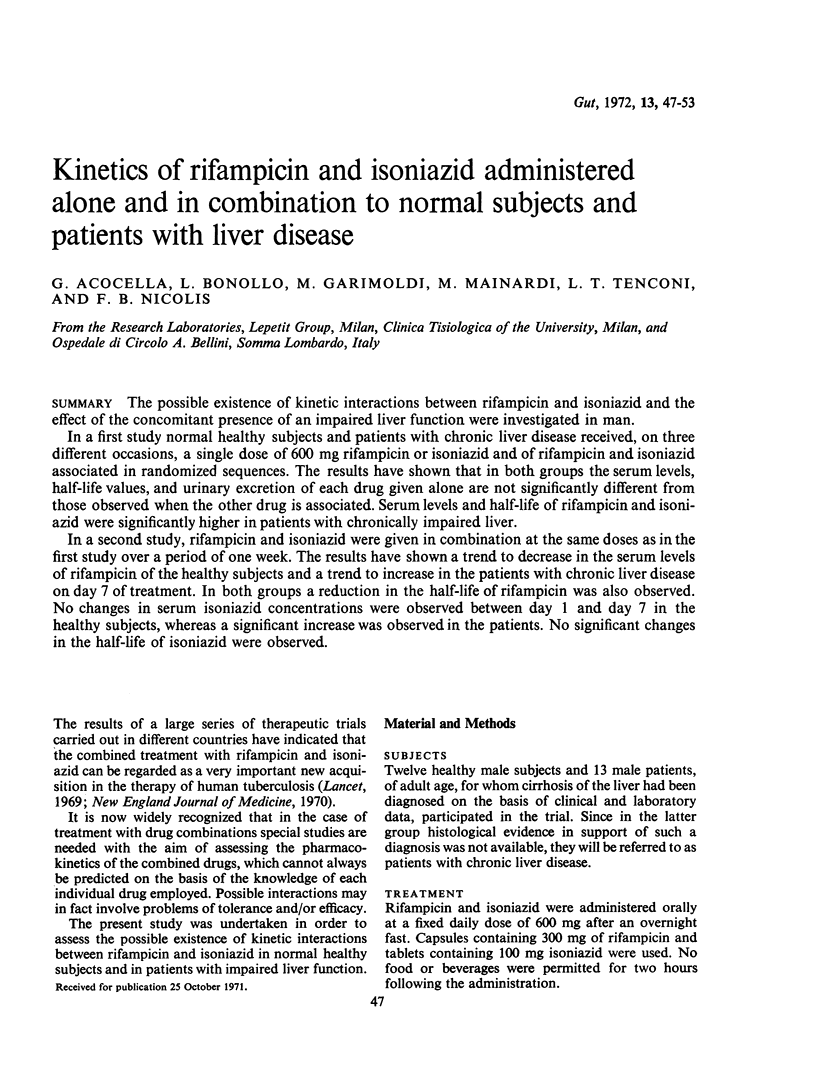
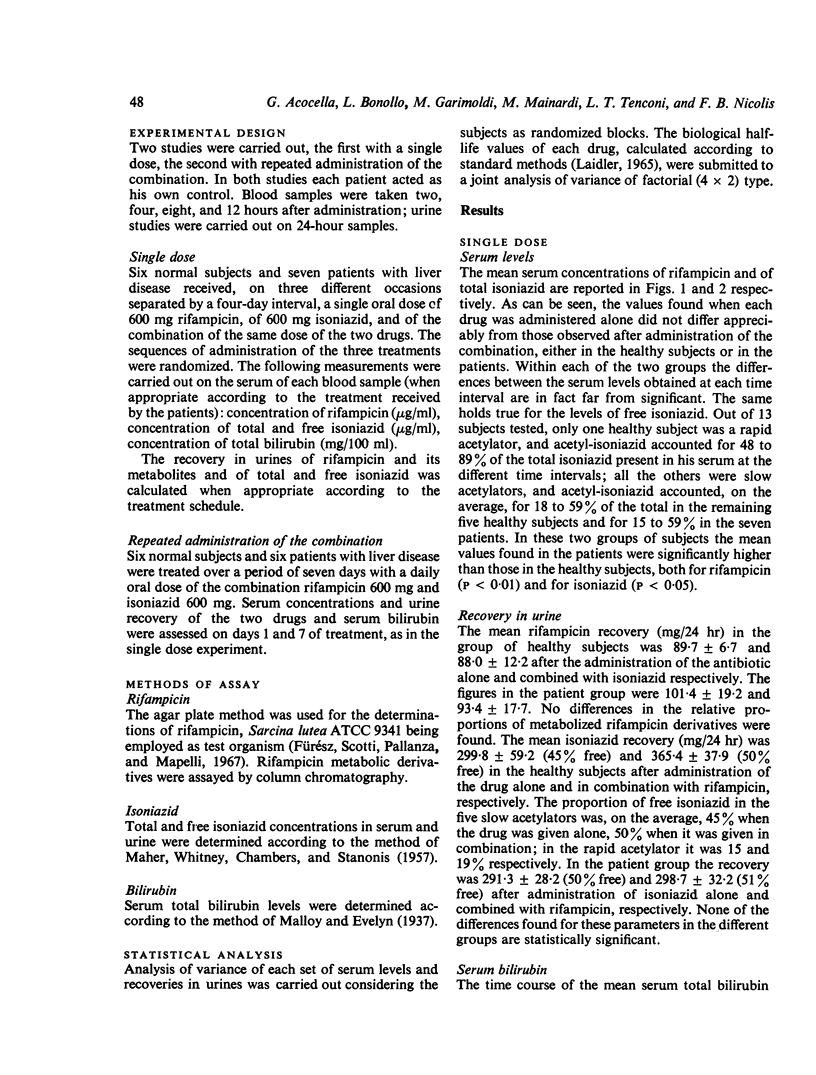
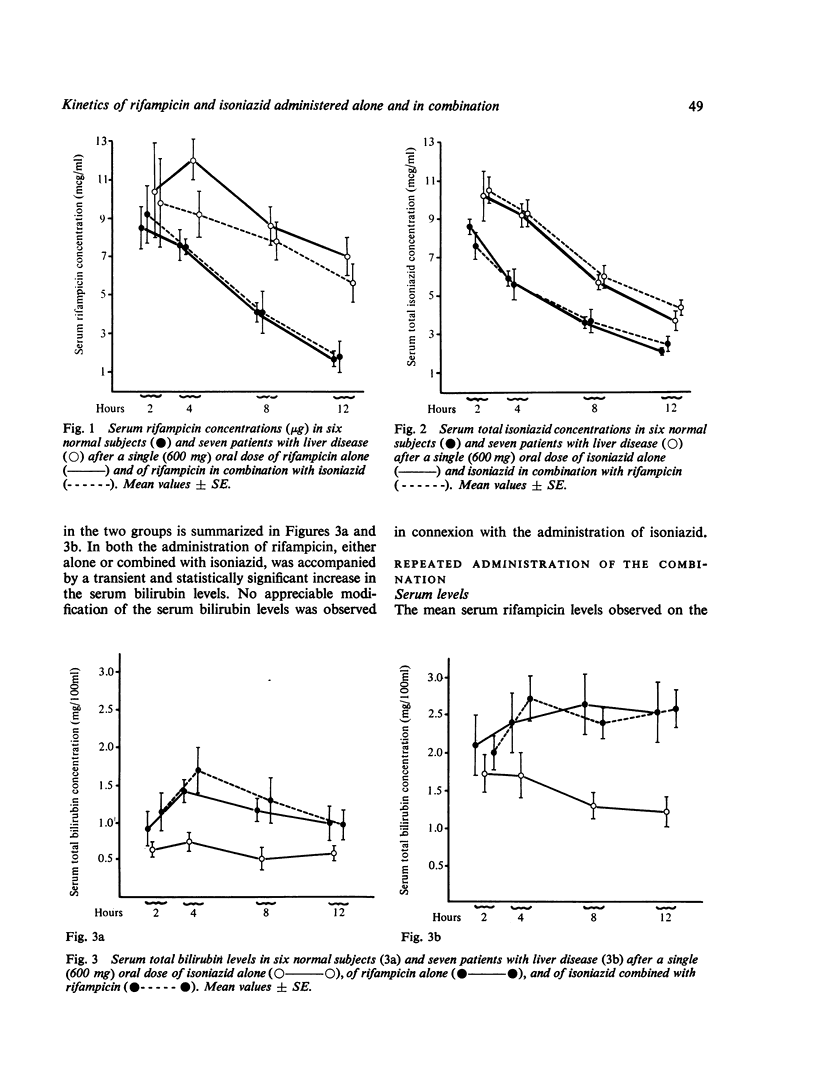

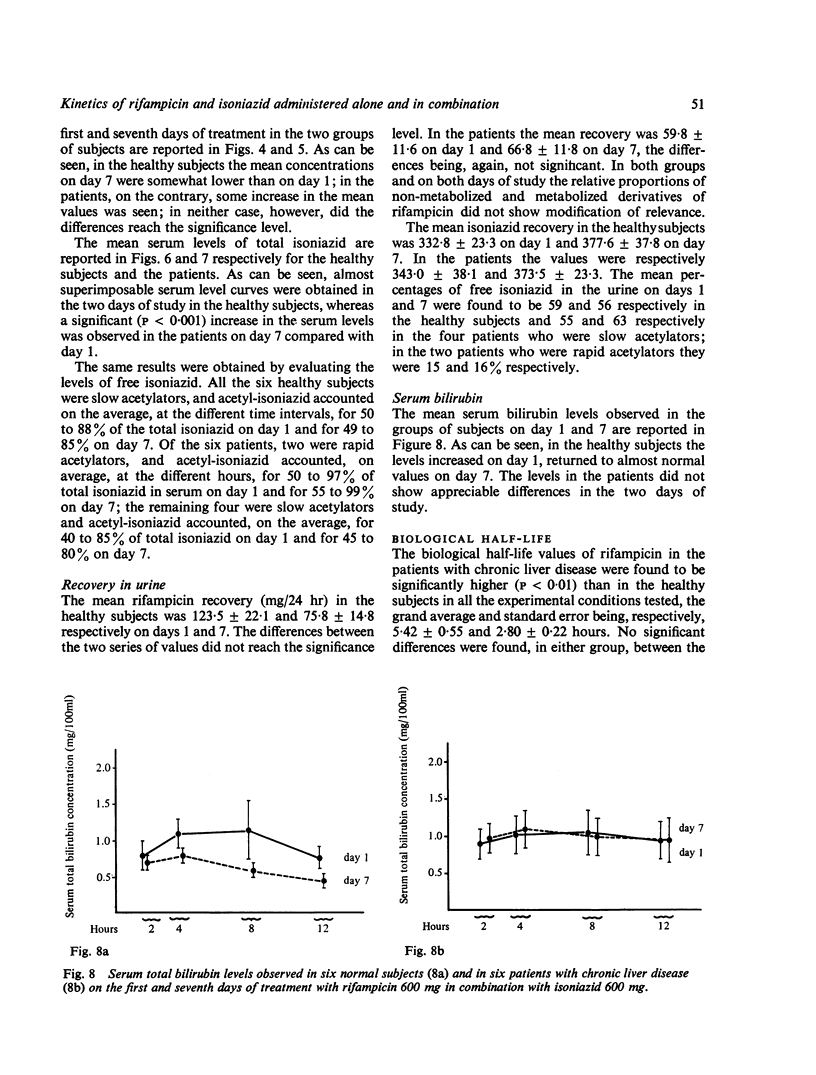
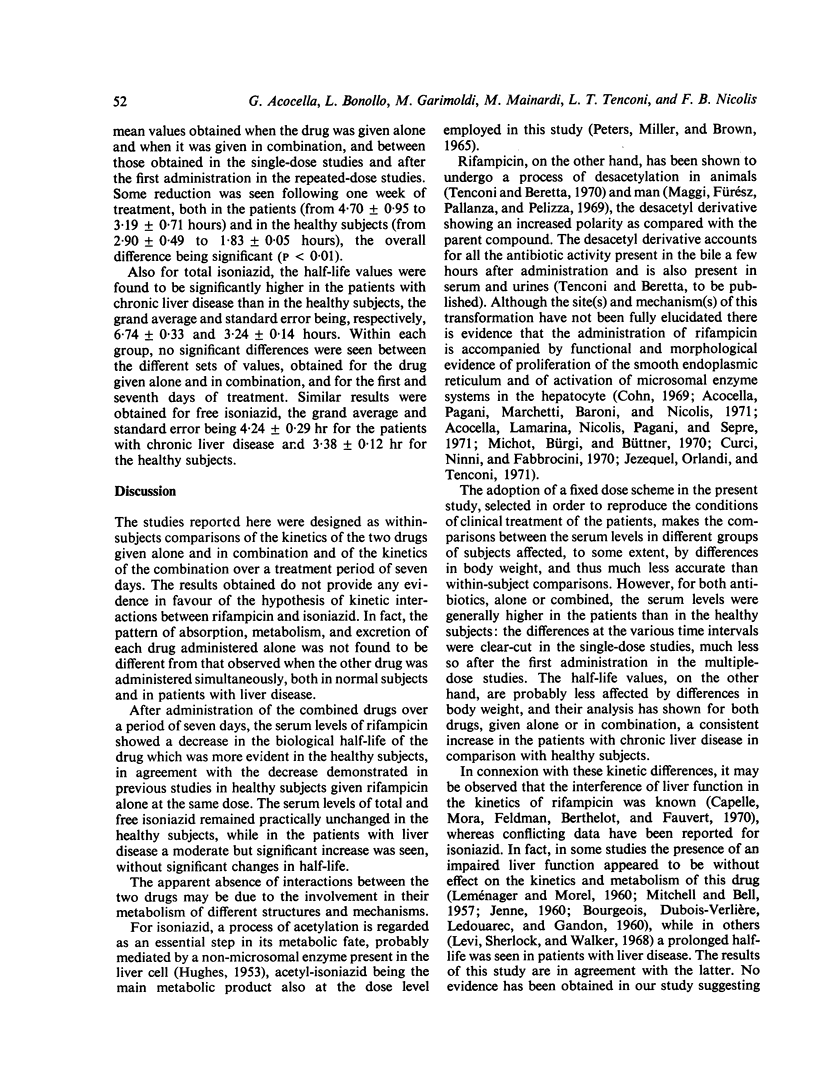
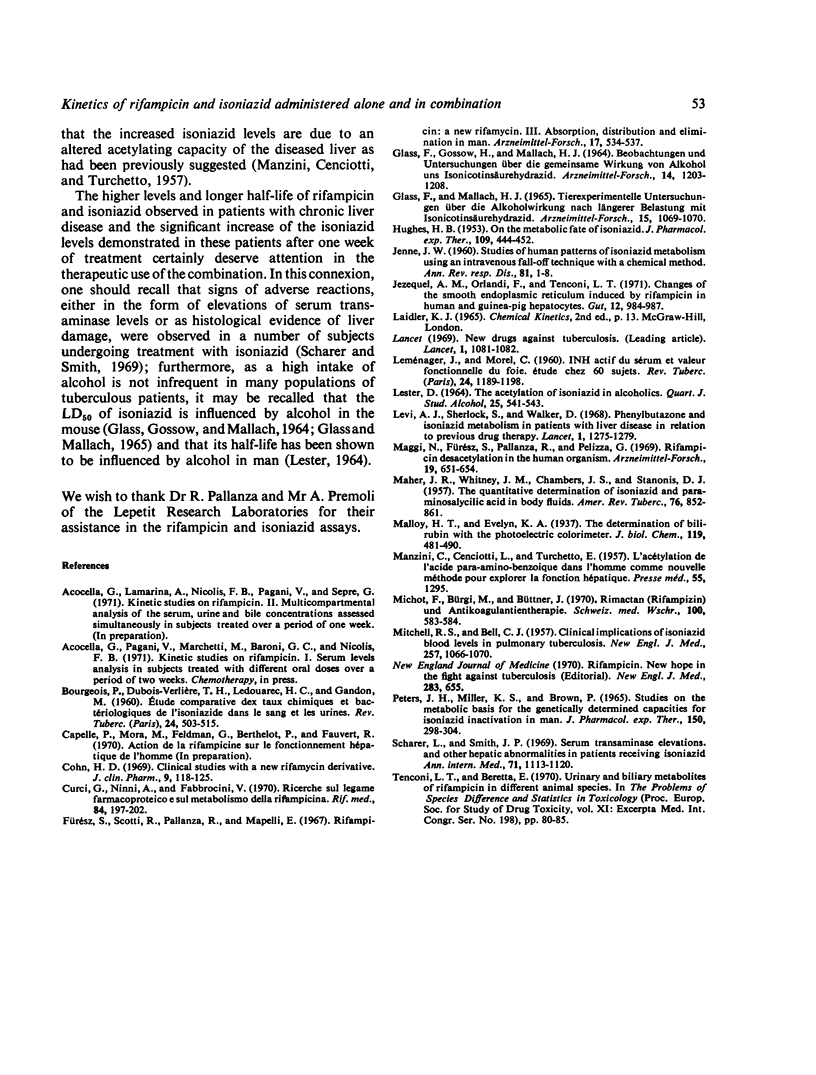
Selected References
These references are in PubMed. This may not be the complete list of references from this article.
- BOURGEOIS P., DUBOIS-VERLIERE T., LEDOUAREC J. C., GANDON [Comparative study of chemical and bacteriological methods of assay for isoniazid in the blood and urine]. Rev Tuberc Pneumol (Paris) 1960 Apr;24:503–515. [PubMed] [Google Scholar]
- Cohn H. D. Clinical studies with a new rifamycin derivative. J Clin Pharmacol J New Drugs. 1969 Mar-Apr;9(2):118–125. [PubMed] [Google Scholar]
- Furesz S., Scotti R., Pallanza R., Mapelli E. Rifampicin: a new rifamycin. 3. Absorption, distribution, and elimination in man. Arzneimittelforschung. 1967 May;17(5):534–537. [PubMed] [Google Scholar]
- GLASS F., GOSSOW H., MALLAH H. J. BEOBACHTUNGEN UND UNTERSUCHUNGEN UEBER DIE GEMEINSAME WIRKUNG VON ALKOHOL UND ISONICOTINSAEUREHYDRAZID. Arzneimittelforschung. 1964 Nov;14:1203–1208. [PubMed] [Google Scholar]
- Glass F., Mallach H. J. Tierexperimentelle Untersuchungen über die Alkoholwirkung nach längerer Belastung mit Isonicotinsäurehydrazid. Arzneimittelforschung. 1965 Sep;15(9):1069–1070. [PubMed] [Google Scholar]
- HUGHES H. B. On the metabolic fate of isoniazid. J Pharmacol Exp Ther. 1953 Dec;109(4):444–452. [PubMed] [Google Scholar]
- JENNE J. W. Studies of human patterns of isoniazid metabolism using an intravenous fall-off technique with a chemical method. Am Rev Respir Dis. 1960 Jan;81:1–8. doi: 10.1164/arrd.1960.81.1.1. [DOI] [PubMed] [Google Scholar]
- Jezequel A. M., Orlandi F., Tenconi L. T. Changes of the smooth endoplasmic reticulum induced by rifampicin in human and guinea-pig hepatocytes. Gut. 1971 Dec;12(12):984–987. doi: 10.1136/gut.12.12.984. [DOI] [PMC free article] [PubMed] [Google Scholar]
- LESTER D. THE ACETYLATION OF ISONIAZID IN ALCOHOLICS. Q J Stud Alcohol. 1964 Sep;25:541–543. [PubMed] [Google Scholar]
- Levi A. J., Sherlock S., Walker D. Phenylbutazone and isoniazid metabolism in patients with liver disease in relation to previous drug therapy. Lancet. 1968 Jun 15;1(7555):1275–1279. doi: 10.1016/s0140-6736(68)92292-7. [DOI] [PubMed] [Google Scholar]
- MAHER J. R., WHITNEY J. M., CHAMBERS J. S., STANONIS D. J. The quantitative determination of isoniazid and para-aminosalicylic acid in body fluids. Am Rev Tuberc. 1957 Nov;76(5):852–861. doi: 10.1164/artpd.1957.76.5.852. [DOI] [PubMed] [Google Scholar]
- MANZINI C., CENCIOTTI L., TURCHETTO E. L'acétylation de l'acide para-amino-benzoique dans l'homme comme nouvelle méthode pour explorer la fonction hépatique. Presse Med. 1957 Jul 10;65(55):1295–1295. [PubMed] [Google Scholar]
- MITCHELL R. S., BELL J. C. Clinical implications of isoniazid blood levels in pulmonary tuberculosis. N Engl J Med. 1957 Nov 28;257(22):1066–1070. doi: 10.1056/NEJM195711282572202. [DOI] [PubMed] [Google Scholar]
- Maggi N., Furesz S., Pallanza R., Pelizza G. Rifampicin desacetylation in the human organism. Arzneimittelforschung. 1969 Apr;19(4):651–654. [PubMed] [Google Scholar]
- Michot F., Bürgi M., Büttner J. Rimactan (Rifampizin) und Antikoagulantientherapie. Schweiz Med Wochenschr. 1970 Mar 28;100(13):583–584. [PubMed] [Google Scholar]
- Peters J. H., Miller K. S., Brown P. Studies on the metabolic basis for the genetically determined capacities for isoniazid inactivation in man. J Pharmacol Exp Ther. 1965 Nov;150(2):298–304. [PubMed] [Google Scholar]
- Scharer L., Smith J. P. Serum transaminase elevations and other hepatic abnormalities in patients receiving isoniazid. Ann Intern Med. 1969 Dec;71(6):1113–1120. doi: 10.7326/0003-4819-71-6-1113. [DOI] [PubMed] [Google Scholar]


